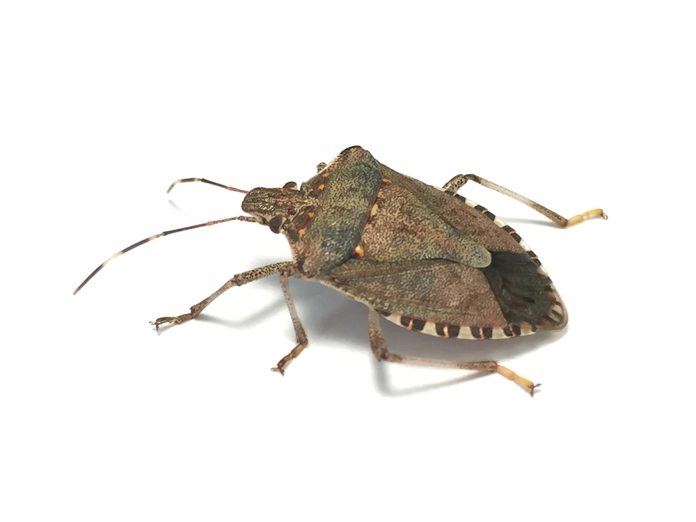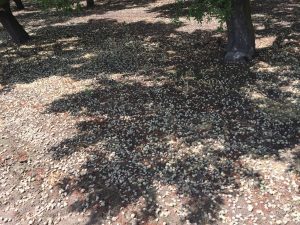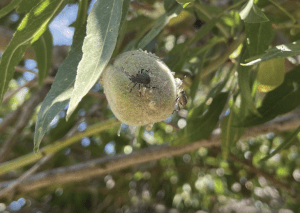
California almond growers, particularly those in the Northern San Joaquin Valley and some areas of Fresno County, are seeing an increase in brown marmorated stink bug (BMSB) activity, according to a University of California area IPM advisor. And, going forward, they should monitor for the pest beginning in spring.
Jhalendra Rijal, UCCE area integrated pest management advisor for the North San Joaquin Valley, said knowing the presence and pressure of BMSB in spring is critical for minimizing feeding damage.
“I encourage growers, at least in our area in the Northern San Joaquin Valley where we now have plenty of evidence that pretty much every corner of these counties has brown marmorated stink bug, to use commercially available lures and traps for the BMSB beginning in spring,” Rijal said.
“Early detection is important,” he added. “When you start seeing gummy nuts, at that point, even though you spray, you won’t be able to save those damaged nuts. And when you see those nuts already on the ground, it is obviously too late.”
Rijal said pest pressure is high this year, not only for BMSB but also for leaffooted bug. Even the green stink bug, which usually is not problematic due to its late-season arrival in orchards, has been a problem this year.
“It can cause some damage, but usually it comes on later in the season,” he said. “This year, we saw it in the spring.
“I would say that all together, we have had above-average plant bug and stink bug activity this year,” Rijal said.
Rijal attributed much of this year’s increase in pressure to a mild winter and warm spring. “These insects, leaffooted bug and brown marmorated stink bug, and other native stink bugs overwinter as an adult,” he said. “So, whenever you have these mild winters, it is likely that we will start seeing activity of these bugs earlier. And that will trigger higher populations of these insects, and you can expect higher levels of damage.”
Difficult to Control
The brown marmorated stink bug can be difficult to control, Rijal said. “It is probably the most challenging hemiptera bug to control because they are active throughout the season and move back-and-forth from other hosts, such as trees of heavens, into orchards. And they overlap generations, so there are often a mix of nymphs and adults in the orchard.
“We are seeing them establishing in newer areas, and once they establish, they can cause significant damage, and we need to be aware of that,” he added.
Also, Rijal said, the pest, which first was identified in a California nut orchard in 2017, appears to be adaptable to high temperatures. “Even at 100 degrees [F], the nymphs are underneath the canopy, doing their job, feeding.”
Adding to difficulties, there aren’t many insecticides that are effective against it outside of pyrethroids, which can be harmful to beneficial insects.
“The majority of the products available are broad-spectrum pyrethroids,” Rijal said, “and there aren’t many newer chemistries coming out. And, because of that, when you apply them early season, there are a lot of consequences you may have to deal with, such as mites.
“So, that is a challenge. But, at the same time, when you have evidence of damage historically, and there is evidence of leaffooted and BMSB activity, you may not have a choice,” he said. “So, that is the challenge.”
Further, despite that UC Davis researchers are working on developing treatment thresholds, there are none established at this point.
“We are working to develop some sort of guidelines or a baseline that a grower can use to help determine when to spray, but that is still a couple of years out,” he said.
Also, he said, hopes that resident predators would help control the BMSB have not materialized. “Unfortunately, there has not been enough evidence that the beneficial insect or the native parasitoid wasp is causing significant population reduction for either the leaffooted bug or the stink bug.”
There is still hope on this front, however. Researchers from various agencies are partnering to test release a BMSB-specific parasitic wasp in the near future, Rijal said, and the non-native wasp has shown a high level of parasitism, approximately 70%, in different research studies.

Predator Stink Bug
When monitoring for BMSB, Rijal said it is important for growers and PCAs to distinguish between a predator stink bug, the rough stink bug, which is similar in size and color to BMSB, and the brown marmorated stink bug.
“Although there are other stink bugs, like the green stink bug, the Uhler’s stink bug and the redshouldered stink bug that can also cause damage, the rough stink bug is not known to cause damage, and it is important to know the difference between it and the brown marmorated stink bug,” Rijal said.
Two distinguishing characteristics that can help differentiate between the two bugs is to look for two clear, white bands on the antennae of the bug. “That is very clear on the BMSB but not so obvious on the rough stink bug,” Rijal said. Also, the shoulder of the rough stink bug has a spine-like rough structure, while the BMSB has more of a smooth shoulder, he said.
Those unsure whether they have found a BMSB or a rough stink bug can take a picture of the bug and send it to their IPM advisor. “It is not difficult [to distinguish the difference] once you know how to identify the difference,” Rijal said.
Rijal added that finding stink bugs and leaffooted bugs in an orchard through visual observation is not easy. “When you look in a tree and do the visual sampling, it is very difficult to find them,” he said.
“We as researchers, we monitor every week in places where they are likely to be found, so we are trained to find them,” he said. “But that is not the case for the general public and growers. It is easy to miss them.”
Still, he said, visual scouting in combination with trapping is important for early detection.

‘It is Spreading’
To date, researchers have yet to see large-scale BMSB activity in crops south of Fresno. “I think it is slow establishing down south because it is hot and dry. But in the Northern San Joaquin Valley and the Sacramento Valley, we have established populations in the urban and residential areas, and also in almonds in the Northern San Joaquin Valley,” Rijal said. “It is spreading.”
Despite the lack of a treatment threshold for BMSB and the lack of an attractant for the leaffooted bug, scouting and trapping beginning early in the season will be key to minimizing damage from both pests in the future, Rijal said.
“We don’t have any tangible lure that we can use for the leaffooted bug yet,” he said. “But for both the BMSB and the leaffooted bug, the main thing we can do is not only trapping, but also thorough scouting of the orchard, especially in the spring, and especially in areas where there has historically been damage.
“Visual monitoring and putting traps out early in the spring are both important options,” Rijal said, “because early detection is important.”















